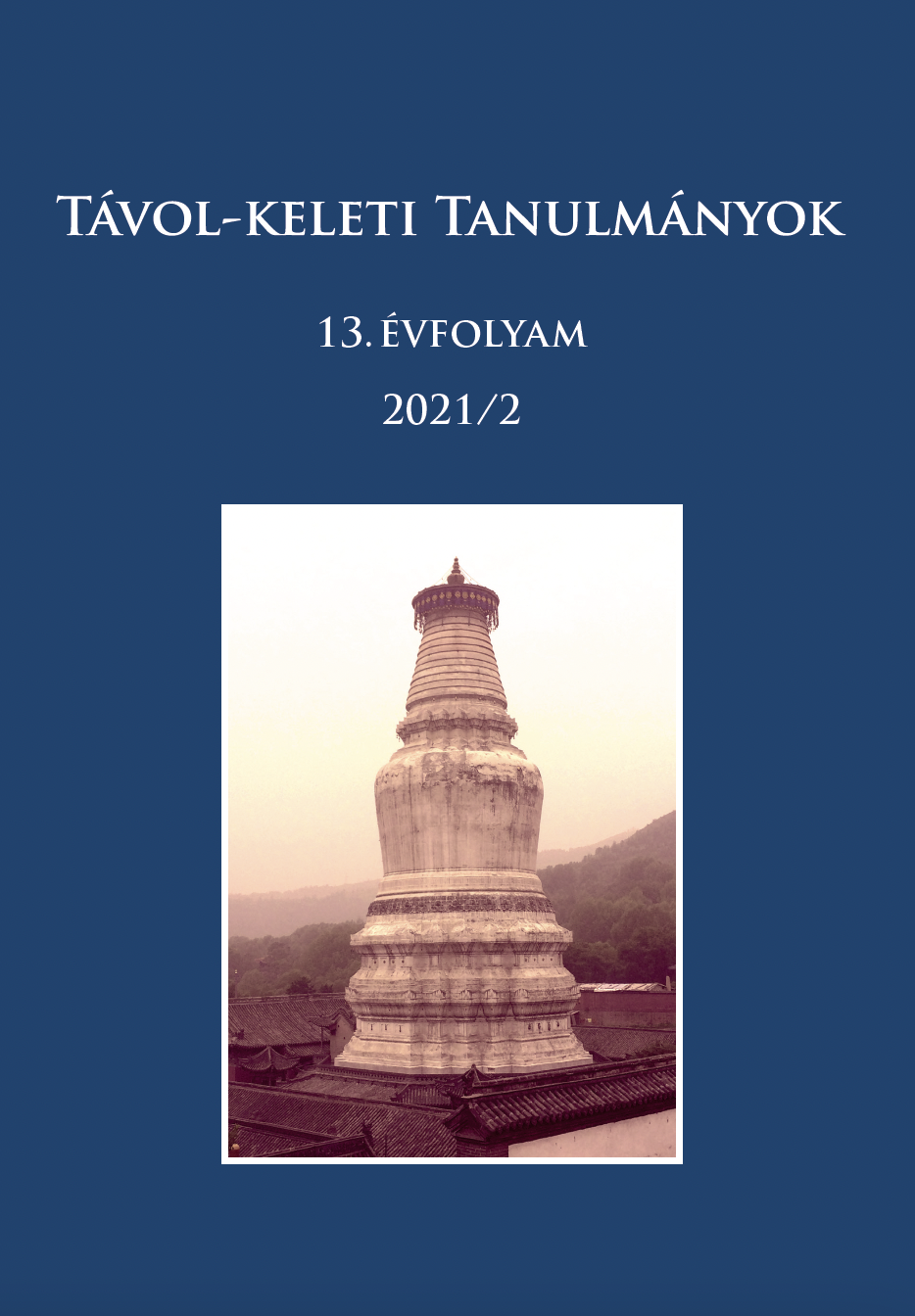Megjelent 2022-09-05
Kulcsszavak
- felsőoktatás,
- kutatói szabadság,
- Meiji Japán,
- Kume Kunitake,
- Tomizu Hirondo
- sintó,
- japán–orosz háború ...Tovább
Hogyan kell idézni
Copyright (c) 2022 Balázs Szabó

This work is licensed under a Creative Commons Attribution-NonCommercial 4.0 International License.
Absztrakt
A fiatal Meiji-állam felismerte a nyugati technológia átvételének hajszájában, hogy annak teljes megértéséhez a mögötte álló tudományokat és tudományos szemléletet is át kell vennie – ennek megfelelően már a restauráció után elindult a modern japán felsőoktatás létrehozásának folyamata, amelynek első eredménye a Tokiói Császári Egyetem lett. A tudományos és egyetemi világ meghonosodásával párhuzamosan az akadémiai szabadság és az egyetemi autonómia eszméit is átvették ugyan, de nem kellett sokat várni arra, hogy konfliktus robbanjon ki a nemzet ideológiai alapjait építő Meiji-kormány és az egyetem eredményeiket publikáló kutatói között – cikkemben két ilyen esetet vizsgálok meg, az 1893-as Kume- és az 1905-ös Tomizu-ügyet. Bár mindkét ügy az érintett professzor elbocsájtásával járt, komoly különbségek figyelhetők meg köztük: míg a történész Kume Kunitake esetében a kormányzat minden ellenállás nélkül keresztülvitte akaratát és megbüntette a tudóst, Tomizu Hirondo ügyéből az egész japán császári egyetemi világot megrázó botrány lett, amelynek végén éppen a kormánynak kellett visszavonulót fújnia.
Hivatkozások
- Breen, John 1996. “The Imperial Oath of April 1868: Ritual, Politics, and Power in the Restoration.” Monumenta Nipponica, 51.4: 407–29. https://doi.org/10.2307/2385417
- Brownlee, John S. 1983. History in the service of the Japanese nation. Toronto: University of Toronto – York University.
- Brownlee, John S. 2000. “Why prewar Japanese historians did not tell the truth?” The Historian 62.2: 343–356. https://doi.org/10.1111/j.1540-6563.2000.tb01444.x
- Chamberlain, Basil Hall 1890. Things Japanese. Being notes on various subjects connected with Japan. London: Kegan Paul, Trench, Trübner & Co.
- Gordon, Andrew 1988. “The Crowd and Politics in Imperial Japan: Tokyo 1905-1918.” Past & Present 121: 141–170. https://doi.org/10.1093/past/121.1.141
- Hall, John Whitney 1965. “Changing conceptions of the modernization of Japan.” In: Marius B Jansen ed. Changing Japanese Attitudes Toward Modernization. Princeton: Princeton University Press, 7–42. https://doi.org/10.1515/9781400875672-002
- Hardacre, Helen 1988. “The Shintō Priesthood in Early Meiji Japan: Preliminary Inquiries.” History of Religions 27.3: 294–320. https://doi.org/10.1086/463124
- Ienaga Saburō 家永三郎 1972. Tsuda Sōkichi no shisōshiteki kenkyū 津田左右吉の思想史的研究. Tokyo: Iwanami.
- Jones, H. J. 1974. “Bakumatsu foreign employees.” Monumenta Nipponica 29.3: 305–327. https://doi.org/10.2307/2383670
- Kume Kunitake 久米邦武 1989. „Komonjo no kenkyū 古文書の研究 [A régi dokumentumok vizsgálata].” In: Ōkubo Toshiaki et al. eds. Kume Kunitake rekishi chosaku shū 4. Tokyo: Yoshikawa Kōbunkan.
- Kuroda, Toshio – Dobbins, James C. – Gay, Suzanne 1981. “Shinto in the history of Japanese religion.” The Journal of Japanese Studies 7.1: 1–21. https://doi.org/10.2307/132163
- Lone, Stewart 2000. Army, empire and politics in Meiji Japan. The three careers of General Katsura Tarō. Basingstoke: MacMillan. https://doi.org/10.1057/9781403919632
- Maeda Tamaki 2012. “From feudal hero to national icon: the Kusunoki Masashige image, 1660–1945.” Artibus Asiae 72.2: 201–264.
- Marshall, Byron K. 1967. Capitalism and nationalism in prewar Japan. The ideology of the business elite, 1868-1941. Stanford: Stanford University Press. https://doi.org/10.2307/1853834
- Marshall, Byron K. 1977. „Professors and politics: the Meiji academic elite.” The Journal of Japanese Studies 3.1: 7–97. https://doi.org/10.2307/132013
- Marshall, Byron K. 1978. „Academic factionalism in Japan. The case of the Tōdai economics department, 1919-1939.” Modern Asian Studies 12.4: 529–551. https://doi.org/10.1017/S0026749X00006314
- Marshall, Byron K. 1992. Academic freedom and the Japanese imperial university, 1868–1939. Berkeley/Los Angeles: University of California Press. https://doi.org/10.1525/9780520912533
- Mehl, Margaret 1993. „Scholarship and ideology in conflict: the Kume affair, 1892.” Monumenta Nipponica 48.3: 337–357. https://doi.org/10.2307/2385130
- Miller, Frank O. 2021. Minobe Tatsukichi: interpreter of constitutionalism in Japan. Berkeley: University of California Press.
- Mizoguchi Koji 2013. The archeology of Japan. From the earliest rice farming villages to the rise of the state. Cambridge: Cambridge University Press. https://doi.org/10.1017/CBO9781139034265
- Morioka Kiyomi 1977. “The appearance of ‘ancestor religion’ in modern Japan: the years of transition from the Meiji to the Taishō periods.” Japanese Journal of Religious Studies 4.2-3: 183–212. https://doi.org/10.18874/jjrs.4.2-3.1977.183-212
- Nakai, Kate Wildman 2017. “Between Secularity, Shrines, and Protestantism: Catholic Higher Education in Prewar Japan.” Japan Review 30: 97–127.
- Pradel, Chari 2014. “’Portrait of Prince Shōtoku and two princes’: from devotional painting to Imperial object.” Artibus Asiae 74.1: 191–219.
- Ravina, Mark J. 2010. “The apocryphal suicide of Saigō Takamori: samurai, ‘seppuku’, and the politics of legend.” The Journal of Asian Studies 69.3: 691–721. https://doi.org/10.1017/S0021911810001518
- Shogimen, Takashi 2010. „’Another’ patriotism in Early Shōwa Japan (1930-1945).” Journal of the History of Ideas 71.1: 139–160. https://doi.org/10.1353/jhi.0.0072
- Shogimen, Takashi 2014. “Censorship, academic factionalism, and university autonomy in wartime Japan: the Yanaihara incident reconsidered”. The Journal of Japanese Studies 40.1: 57–85. https://doi.org/10.1353/jjs.2014.0011
- Smith, Henry D. 1972. Japan’s first student radicals. Cambridge: Harvard University Press.
- Steinberg, John W. 2008. “Was the Russo-Japanese war world war zero?” The Russian Review 67.1: 1–7. https://doi.org/10.1111/j.1467-9434.2007.00470.x
- Tachibana Takashi 立花隆 2005. Tennō to Tōdai: Dai Nippon teikoku no shō to shi 天皇と東大大日本帝国の生と死 [A császár és a Tokió Egyetem: a Nagy-Japán Császárság születése és bukása]. Tokyo: Bungei-shunjū.
- Teeuwen, Mark 1997. “Poetry, Sake, and Acrimony. Arakida Hisaoyu and the Kokugaku Movement.” Monumenta Nipponica 52.3: 295–325. https://doi.org/10.2307/2385631
- Townsend, Susan C. 2000. Yanaihara Tadao and Japanese colonial policy. Redeeming empire. Richmond: Curzon.

